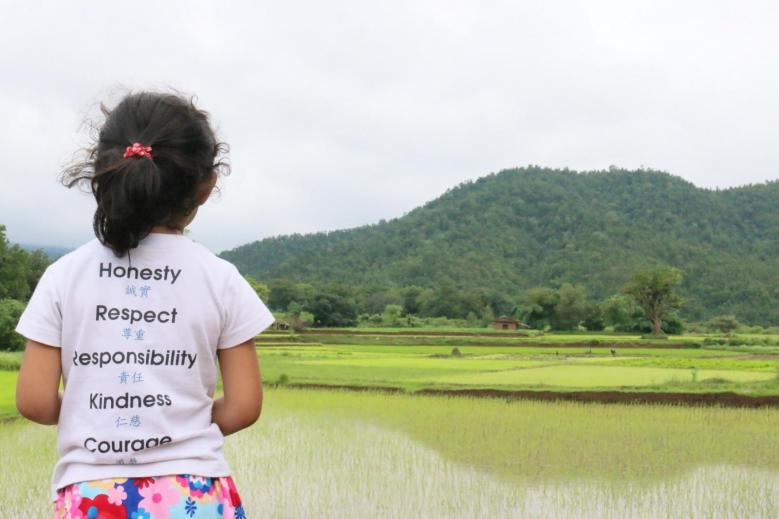
Article Series: Energy as an Anchor of USAID’s New Climate Strategy:
Originally published in June 02, 2022.
This blog was published in Powerline Magazine and Climatelinks platform as part of an article series titled, “Catalysing South Asia’s Clean Energy Transition”. The initiative was led by United States Energy Association under USAID/India stewardship and first published in Powerline Magazine followed by republication on USAID's Climatelinks platform.
Drafted by: Alex Lane, Energy Division Lead, USAID Center for Environment, Energy and Infrastructure
Photo credit: Anchal Singh on Youth for Climate Action, as published in Climatelinks
Our world is the most interconnected it has ever been. This has been demonstrated time and again through shared health experiences, geopolitical interests and conflicts, and natural disasters that collectively upend communities, supply chains and livelihoods. The climate crisis is the thread that connects these simultaneous and compounding issues.
People around the world are increasingly seeing heat waves, droughts, floods and wildfires disrupt their lives. South Asia is no exception as the recent heatwave has unfortunately reminded us. In addition to these extreme events, the urban heat island effect and air pollution are making life in the city, where most people now live, a health hazard on a daily basis.
This decade will be decisive for the future of our planet. That is why USAID has developed a new Climate Strategy that will guide our humanitarian and development work through 2030 in a way that is truly different – by calling on all corners of USAID to play a part in our whole-of-agency response.
We have developed six targets to achieve by 2030 that capture our ambition for what we hope to do in partnership with governments, civil society, academia, private firms, communities and other donors.
- Mitigation: Reduce, avoid, or sequester 6 billion metric tonnes of carbon dioxide equivalent.
- Natural and managed ecosystems: Support the conservation, restoration, or management of 100 million hectares with a climate change mitigation benefit.
- Adaptation: Enable the improved climate resilience of 500 million people.
- Finance: Mobilise $150 billion in public and private finance for climate.
- Country support: Align USAID programmes with 80 countries’ mitigation and adaptation commitments by 2024, and support partners to achieve systemic changes toward meeting those commitments in at least 40 countries.
- Critical populations: Support our partners to achieve systemic changes that increase meaningful participation and active leadership in climate action of indigenous peoples, local communities, women, youth and other marginalised and/or underrepresented groups in at least 40 partner countries.
Our energy sector programming will support five of these six objectives. In South Asia, USAID will expand upon the foundation already established by regional projects like the South Asia Regional Energy Partnership (SAREP), South Asia Group for Energy (SAGE), and South Asia Regional Initiative for Energy Integration (SARI/EI). Our shared goal of an interconnected, energy secure South Asia is supported through specific country programmes in Nepal, Bangladesh and Sri Lanka. Our actions build the technical capacity of our partners to scale up and integrate renewable energy technologies, incentivise energy efficiency standards, support clean and sustainable supply chains and transport systems, and reduce emissions of powerful but short-lived climate pollutants, like methane and nitrous oxide.
Creating an attractive investment climate for low emission technologies and infrastructure is essential for ensuring a successful clean energy transition. The mobilisation of climate finance can drive localisation efforts because it helps governments and private sector entities avoid accumulating unsustainable debt as they pivot to climate-friendly investments. Accordingly, USAID supported the development of India’s first green bonds as a solution to address the investment gap in renewable energy in the Indian market. Today, India has become the world’s second-largest market for green bonds, but much untapped potential still exists. USAID is continuing to build that potential through support for India’s first sovereign green bond, which will be issued this year.
To be successful, our collective effort to mitigate greenhouse gas emissions while expanding access to affordable and reliable energy must improve the welfare of the poorest and empower those striving for equality. We are committed to engaging with local communities, not just national governments, on long-term roadmaps for sustainable change that consider local contexts, increase gender equality and social inclusion, strengthen local institutions, and evaluate the social benefits and costs of proposed pathways. As the energy sector is among the most gender imbalanced sectors in the region, USAID’s Engendering Industries programme is partnering with key utilities to design gender equitable workplace initiatives that expand tangible economic opportunities for women, such as access to technical and leadership positions, increases in pay equity, and promotions, in India’s energy sector while advancing the business goals of each company.
Around the world, poor communities are not only suffering from the impacts of climate change most acutely, but they have long been exposed to the side effects of dirty energy production. The Clean Air Catalyst program is working in the city of Indore to better understand the different sources of air pollution and their impacts on climate, gender equality and health, with a focus on sources that have a disproportionate impact on women, low-income and marginalised communities. These groups will then be included in the development of air pollution solutions to ensure that their priorities and needs are met.
Through USAID’s new strategy coupled with a longstanding foundation of climate and environment programmes around the world and in the South Asia region, the Agency is looking forward to doing all we can to advance equitable and ambitious actions to confront the climate crisis together with our partners and allies around the world. Our future depends on it.
